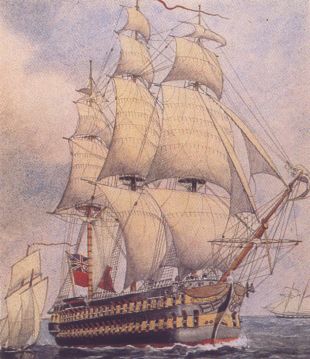HMS St Lawrence
His Majesty's Ship St Lawrence, first-rate of 102 guns, largest wooden warship ever launched on Lake Ontario
Length on gun deck: 191' 2" [2], (194' [7] and [3]), (198' [6])
Beam: 52' 7"
Draft: Afore 11/19, Abaft 13/20 (light/heavy)
Tonnage: 2305 tons (2304)
Keel: 170' (172' 6" [1]) laid late March 1814 at Point Frederick naval shipyard, Master Shipwright William Bell
Launched: 10th September, 1814, at 10a.m. (two days later than planned [9]) - total build time was therefore well under six months.
[A comparison of the relative sizes of the St Lawrence and Nelson's HMS Victory is a popular pastime: nearly half a century older, the latter is 186' on the gun deck, 51' 10" beam, 2142 tons, mounting 100 guns for a broadside of 1052 pounds. More relevant might be HMS Nelson, built 1814 thus contemporary with the St Lawrence, at 205' on the gun deck, 53' 9" beam, 2619 tons, 118 guns and a broadside of 1454 pounds. Also, it should be remembered that at the same time Commodore Yeo was building the St Lawrence at Kingston, Commodore Chauncey was building the New Orleans just across Lake Ontario at Sackett's Harbour; this vessel at 212' on the gun deck, 110 guns and 3200 tons, built by Henry Eckford but never launched, was appreciably larger than the St Lawrence. The most significant difference in design parameters when comparing the St Lawrence with saltwater first-rates was her draft - she was considerably shallower to suit Lake conditions.]
Armament: designed to be pierced (16, 17, 18 ports [6]) for 102 guns: long 32pdrs on the lower deck, long 24pdrs on the middle deck and 32pdr carronades on the spar deck - configuration later changed to all decks pierced for 17 ports; two 68pdr carronades ('smashers') were added, as was at least one swivel (Fort Henry Museum).

Watercolour by C.J.H. Snider,
dramatic, if slightly inaccurate [10]
Weight of broadside: evidence suggests that the total armament was in fact achieved (at the expense of a number of other ships at Quebec, Montreal, on the St Lawrence and Lake Ontario); she thus mounted a broadside of seventeen 32pdrs, plus seventeen 24pdrs, plus seventeen 32pdr carronades and a 68pdr smasher, for a total of 1564 lbs (swivels, if any, not included). B. Wishart [note below] gives twenty seven long 32pdrs, forty one long 24pdrs, forty one 32pdr carronades and three smashers, but does not quote sources. This, does not divide neatly into two equal broadsides, but half of this total would amount to 1682 pounds.
The maximum working range of the long guns was in excess of one thousand yards, there being little difference between using a 1/3 charge rather than the more normal 1/4; first graze (extreme range) single shot for both the 24pdr and the 32 pounder at 7º elevation and 1/4 charge is approximately 2200 yards, or just over one mile; carronades were most effective at well less than 500 yards, but required far less crew to handle them.
Maiden voyage: 16 Ocotober 1814, under Captain Frederick Hickey, continuing to Niagara, unloading between the 20th and 22nd those elements of the 90th Foot and provisions that she had on board, and reembarking for Kingston several companies of the 8th and 104th, mostly wounded. However, from the Ridout Letters: "On Lake Ontario Sir James Yeo's grand ship, the St Lawrence, 100 guns [sic], had just been launched, and once more the gallant commodore was lord of the lake, and troops and supplies could now have been easily brought to Drummond's army at Niagara. The war was, however, practically over". [4] The St Lawrence made one more round trip Kingston, Niagara, York and back to Kingston between the 1st and 10th November.
It is popularly stated that the St Lawrence was responsible for "ending the war of 1812"; at a very local level, while there may have been some psychological advantage attached to the St Lawrence, the final American retreat under Brown from the Niagara peninsula was in major part due to other factors; and at a more general level, the burning of Washington, Chippewa and Baltimore, Plattsburg and Fort Erie, the New England anti-war faction and the fiscal situation in England all eclipsed the St Lawrence in the minds and preoccupations of the peace negotiators.
The St Lawrence, contrary to some opinion, was not scuttled as a result of the Rush-Bagot Convention; she was in fact laid up in ordinary as early as the spring of 1815; the masts and guns were taken off, sloping roofs added over the upper deck as protection from the weather and anchored in Navy Bay, then moored alongside where she settled. She was sold [8] at auction for £25 in 1832 to Robert Drummond, who had her towed away to his home at St Helen's, where she was used as the end of a dock at Morton's Distillery and inter alia as storage for fire-wood. While the exact year that she collapsed or finally sank is not known, her remains are still there; two diving surveys (R.G Way, Director, Fort Henry, 1937/8 and Lt.-Commander W.H. Willson R.C.N., 1951) [1] and other more recent "recreational" dives have confirmed this.

"Naval Yard Kingston, 13 April 1814 Dimensions of a Ship
laid down in His Majesty's Naval Yard at Kingston etc . . ." [C-107048]
Bibliography:
[1] Papers and Records (OHS) VII and XLIV/3, Jan 1907, Jul 1952
[2] Papers and Records (OHS) LV/3
[3] The Beaver, Feb 1992
[4] Ten years in Upper Canada in Peace and War 1805-1815, Edgar, M, William Briggs, 1890
[5] Mariner's Mirror XXIX/3, July 1943; LXXXIII/4
[6] C-107048, National Archives of Canada (see below)
[7] Lords of the Lake, Malcomson, R, NIP 1998
[8] Kingston Chronicle, 12 Jan 1832
[9] Select British Documents of the Candian War of 1812, Woods (ed), Champlain Society, 1926
[10] Image of the widely published print. This Society also holds a second print of the "same" watercolour that has obviously been corrected.
